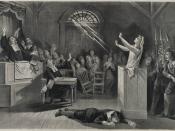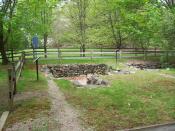Have you ever discovered that people you know are not who you thought they were? In the short story, "Young Goodman Brown", written by Nathaniel Hawthorne, such discoveries are made by the main character. Goodman Brown leaves his home in the Village of Salem to go on a journey through the forest to satisfy his own curiosity. In the story, Hawthorne uses various settings such as the Village of Salem, the forest, and the witch trials to create the mood of disappointment for his story.
The story begins at dusk with Goodman Brown leaving his home in the Salem Village and his wife of only three months to begin a journey. By telling that Goodman Brown is leaving from his home in Salem Village the setting takes the readers thoughts immediately to the Salem Witch Trials that were held in the 1600's. This setting starts the mood of the story and gives the reader a good idea of what the story is about.
Hawthorne will use the setting of the Salem Village in the conclusion of his story as well.
Hawthorne uses the forest as another primary setting for the story. The woods symbolize the darkness and frightfulness of the unknown. Brown describes the forest as a place "that the traveler knows not who may be concealed by the innumerable trunks and the thick boughs overhead; so that with lonely footsteps he may yet be passing through an unseen multitude" (466). As Goodman Brown walks through the forest he thinks, "'What if the Devil himself should be at my very elbow!'"(466). Brown keeps walking further into the dark forest where he encounters a man who we are able to determine portrays the Devil. Everything that Brown saw and experienced in the forest was translated into the real...


